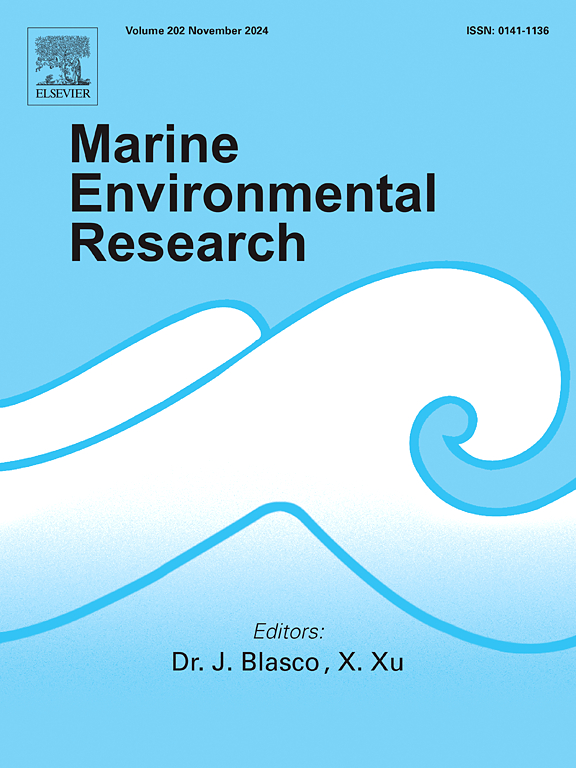海洋酸化对地中海贻贝的长期影响
IF 3
3区 环境科学与生态学
Q2 ENVIRONMENTAL SCIENCES
引用次数: 0
摘要
本研究旨在阐明海洋酸化对一种重要海产品的长期生理影响。地中海贻贝(Mytilus galloprovincialis)在六个月的时间里受到三种pH条件的影响:两种pH值在目前的自然变率范围内(pHT: 8.10和7.80),另一种pH值较低(pHT: 7.50),与近期海洋酸化有关。在第4和第6个月结束时进行了全面评估,包括一系列生理终点,包括死亡率、耗氧量、清除率、总血细胞计数(THC)、营养含量分析和钋-210 (210Po)去除率。研究结果显示,在pH值为7.50的环境中,6个月后的存活率明显低于pH值为8.10和7.80的环境。这与THC的显著增加和脂质含量的减少有关。其他终点(清除率、状态指数、耗氧率、蛋白质和碳水化合物含量以及210Po)均未观察到pH值的显著影响。虽然在这些生理终点中缺乏对低pH值的反应可能是缺乏统计能力的结果,但我们的数据清楚地表明,低pH值对加洛省分枝杆菌的生存、四氢大麻酚和脂质含量的影响。这种对物种整体适应性的影响有可能对关键海产品物种、相关生态系统和依赖该资源的社区的社会经济动态产生负面影响。本文章由计算机程序翻译,如有差异,请以英文原文为准。

Long-term impacts of ocean acidification on the Mediterranean mussel Mytilus galloprovincialis
This study aims to elucidate the long-term physiological impacts of ocean acidification on a key seafood species. The Mediterranean mussel Mytilus galloprovincialis, was subjected to three pH conditions over a period of six months: two pH values within the present range of natural variability (pHT: 8.10 and 7.80) and a lower pH condition (pHT: 7.50) relevant in the context of near-future ocean acidification. A comprehensive assessment was conducted at the conclusion of the fourth and sixth months and encompassed a suite of physiological endpoints, including mortality, oxygen consumption, clearance rate, total haemocyte count (THC), nutritional content analysis, and polonium-210 (210Po) depuration rates. The findings revealed a marked decrease in survival rates at pH 7.50 compared with those at pH 8.10 and 7.80 after six months of exposure. This was associated with a significant increase in THC and a decrease in lipid content. No significant pH effects were observed for other endpoints (namely clearance rate, condition index, oxygen consumption rate, protein and carbohydrate contents, and 210Po). While the lack of response to low pH at some of these physiological endpoints may be a consequence of a lack of statistical power, our data clearly demonstrate the effects of low pH on the survival, THC, and lipid content of M. galloprovincialis. Such effects on a species’ overall fitness have the potential to negatively impact this key seafood species, associated ecosystems, and the socioeconomic dynamics of communities depending on this resource.
求助全文
通过发布文献求助,成功后即可免费获取论文全文。
去求助
来源期刊

Marine environmental research
环境科学-毒理学
CiteScore
5.90
自引率
3.00%
发文量
217
审稿时长
46 days
期刊介绍:
Marine Environmental Research publishes original research papers on chemical, physical, and biological interactions in the oceans and coastal waters. The journal serves as a forum for new information on biology, chemistry, and toxicology and syntheses that advance understanding of marine environmental processes.
Submission of multidisciplinary studies is encouraged. Studies that utilize experimental approaches to clarify the roles of anthropogenic and natural causes of changes in marine ecosystems are especially welcome, as are those studies that represent new developments of a theoretical or conceptual aspect of marine science. All papers published in this journal are reviewed by qualified peers prior to acceptance and publication. Examples of topics considered to be appropriate for the journal include, but are not limited to, the following:
– The extent, persistence, and consequences of change and the recovery from such change in natural marine systems
– The biochemical, physiological, and ecological consequences of contaminants to marine organisms and ecosystems
– The biogeochemistry of naturally occurring and anthropogenic substances
– Models that describe and predict the above processes
– Monitoring studies, to the extent that their results provide new information on functional processes
– Methodological papers describing improved quantitative techniques for the marine sciences.
 求助内容:
求助内容: 应助结果提醒方式:
应助结果提醒方式:


